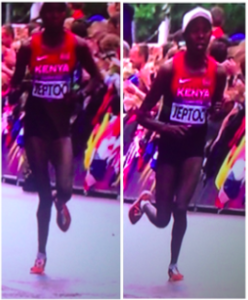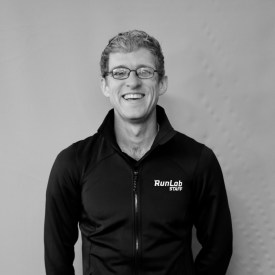You might be wondering how anatomical structure can affect running mechanics. Have you ever heard “You look funny when you run, you should be facing your feet forward!”
This single statement, usually coming from a well-intentioned friend, trainer, coach, or therapist who knows just enough to be dangerous in the world of running biomechanics, accounts for weekly, if not daily, client encounters at RunLab™.
We’ve all heard at one time or another that we need to squat or walk or run with our feet facing forward, but this antiquated look at movement is leading many people down the road to injury on a more frequent basis than you may think.
Curious?
You should be. Understanding your unique structure and the way that you move in relation to it, is vital to both injury prevention and performance development.
If you take a second to really look around your local running group, you will see body shapes that come in every variety imaginable. Short, tall, thick, thin, bow-legged, knock kneed, flat-footed, high-arched, and on and on and on. It is important to make note of your own unique shape and structure because this affects the way you move in relation to the person next to you.
In the rehab and training world, you will frequently hear cues about facing feet forward when walking, squatting, or running. This is merely one example of the way we are too often looking at running with a telescope instead of a microscope. It is true that, across a population, it is more common for people to have neutral positioning of their hip and knee, which allows the foot to face forward without undue stress on the joints above. However, there is a significant portion of the population which has variability in positioning of the hip or knee joint. The tibia (lower leg bone) often faces inward or outward in relation to the femur (thigh bone). In addition, many people may have a slightly outward or inward facing hip joint, positioning their foot slightly in or out naturally.
You can probably already see the issue here. If someone with a structural variable tries to “correct” that variable, over time it will put excess load on an area unaccustomed and poorly positioned to accept that load. This leads not only to injury, but also to inefficient movement patterns and a limitation in performance.
As mentioned above, these trainers and therapists are often well-intentioned. The thought process being that an underlying functional limiter is the cause of this “movement flaw”, as opposed to a structural variable. It is assumed that the runner has a range-of-motion or strength imbalance somewhere in the body that can be “fixed.” However, this is frequently an incorrect assumption and requires assessment by someone who knows how to tell the difference between a structural variable and a functional limiter.A great illustration of structural variability is Marathon Olympic Silver medalist Priscah Jeptoo. Arguably once of the worst looking gaits many of us have seen. However, she is winning marathons…so what gives?

Priscah has what is referred to as valgus knees. Valgus knees are essentially “knock knees”, meaning her knee dives in towards her midline. This structural variable often leads to increased internal femoral rotation, increased tibial rotation and finally rapid and often prolonged pronation. When comparing Priscah to many other runners, the important distinction is that many people have a gait that looks like this because of muscle weakness, which is a functional issue that can be addressed through strength and gait work. However, if you have a structural variable like Priscah, you will never strength train your way out of a valgus knee, no matter how many glute exercises you do. You unique anatomical makeup can make you more adept at performing a certain movement skill, or less adept, depending on the extent of the structural variable and the skill being undertaken. Just as in swimming, gymnastics, dancing, basketball, baseball, football or any other sport, there are dominant body types that tend to be built to succeed in any specific sport. However, there are always outliers and body shapes that don’t fit the “norm” for the sport that still achieve great success. The key is knowing where YOUR unique strengths, weaknesses, and structural limiters are so that you can work with your body’s natural design, not against it.
In the case of Priscah, or any athlete with valgus knees, she is at a higher probability of sustaining injury in the medial (inside) portion of her knees, low back, and shins, along with a few other key areas than someone with neutral knees. To combat the higher probability of injury in these specific areas, her strength work is likely focused on doing more work on strengthening muscles that will counteract these additional forces. This is why understanding your unique weaknesses and structural limiters is vital to formulating a customized plan to tackle your weakest areas and injury-proof your body in the best way possible.
ABOUT LORIN WILSON

Lucky enough to be a part of a great running program in high school, Lorin not only went on to win the 2007 Texas 4a State Championship in the mile but also went on to earn a track scholarship to the University of Texas at Austin. Lorin graduated from the The University of Texas at Austin with a major in Exercise Science and a minor in business. While still attending UT, he began coaching distance running at St. Stephen’s Episcopal school where he would coach student-athletes to break school records in the 400 meter, 800 meter, 1600 meter, 3200 meter, 5000 meter, 4×400 meters, and 4×800 meters. After graduating from UT and during his aforementioned tenure at St. Stephen’s, Lorin also worked for the local Austin non-profit Power For Parkinson’s as a fitness instructor, which provides free fitness programs for individuals with Parkinson’s disease. No longer a trainer at Power For Parkinson’s, Lorin does fundraising campaigns for Power For Parkinson’s. During this period he also started BlueSky Running LLC, which provided on-site Yoga programs for employees of the Austin Independent School District (teachers, administration, bus drivers etc).
Lorin has the following physical training certifications: National Academy of Sports Medicine (NASM) Certified Personal Trainer, Performance Enhancement Specialist (NASM), Corrective Exercise Specialist (NASM), Senior (elderly individuals) Fitness Specialist (NASM), Fitness Nutrition Specialist (NASM), RunLab Clinical Gait Specialist, USA Track & Field Level 1 Coach, and a USA Yoga Alliance 200 Hour Certified Yoga Instructor certification earned while studying in Rishikesh, India. Lorin is a MBA Graduate with an emphasis in Accounting from Texas State University. He was also the President of the Texas State MBA Student Association and a Future Texas Business Hall of Fame Scholarship Recipient.
Lorin has a marathon best of 2:37:05 (5:59 per mile pace) run at the 2011 Los Angeles Marathon. He ran his first 100 miler in 17 hours 30 minutes (10:15 per mile pace) in Flagstaff, Arizona in September 2018. He ran the 2019 Boston Marathon in 2:37:59. He also has three top 10 finishes (5th, 7th, and 10th) in the Capital 10,000, the largest 10k in Texas, with the latest two being 2016 and 2017. Lorin looks forward to working towards his goal of making high-quality fitness accessible to everyone while he continues to train for 100 mile races.
Thank you for taking the time to read our RunLab™ Blog! We hope that you use this information to run more injury free and to optimize your running performance.
For more information about the RunLab™ team and to get your running stride analyzed by one of the preeminent gait specialist teams in the country, please visit WWW.RUNLABAUSTIN.COM
Outside of the Austin area? You can still have your running stride analyzed by one of the best teams in the country. Just visit WWW.RUNLAB.US to see where our partner filming locations are based or choose the self-film option.
RunLab™. Helping runners help themselves.
LEARN MORE:
RunLab™ Podcast RUN.
RunLab™ YouTube channel
